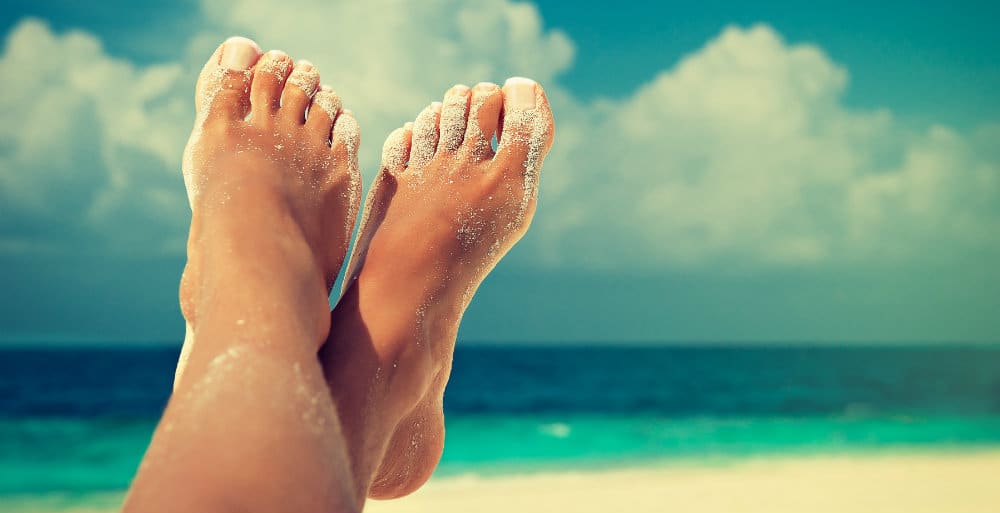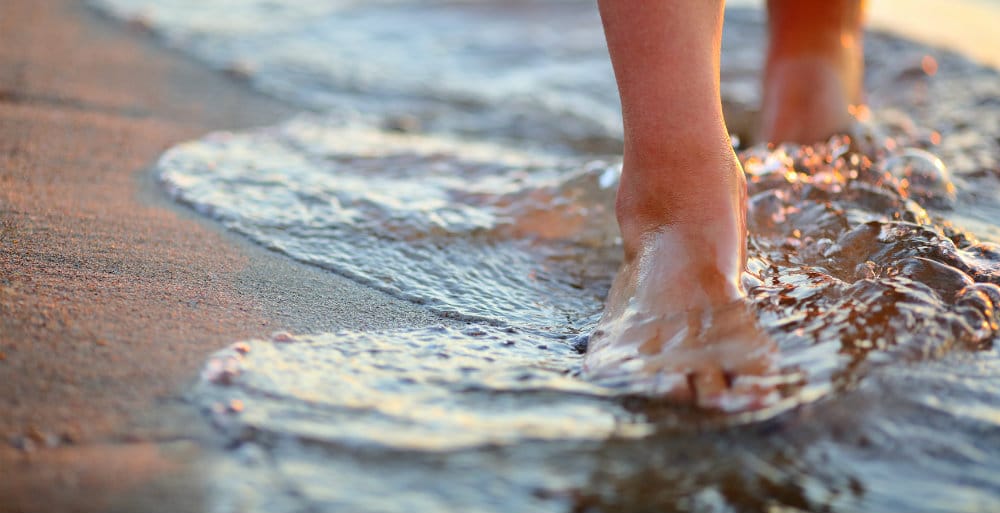Footsteps in the Sand – How to Keep Your Feet Safe at the Beach
Beaches are no rare destination around here! Whether you’re looking for personal time or family fun, there are plenty of options.
Maybe you like going to Crystal Cove State Beach to explore the tidal pools. Or maybe skim boarding at Thousand Steps is more your thing. The kids might even love the main park down in Laguna Beach, with its fun lifeguard tower playground.
Wherever you go along the coast, we want you to have a great time and take in the best of views that only our region can offer!
Buuuut we’re also podiatrists, and we notice that people don’t always keep foot safety in mind when hitting the beach. A fun trip to the sands can become miserable if you end up hobbling back to the car with an injury.
So, when making plans for a day of sun, surf, and exploration, keep these tips for beach foot safety in mind:
Don’t Forget the Sunscreen on Your Feet! – Sunscreen is as important at the beach as wax is on a surfboard. However, the feet often go woefully unprotected whenever the SPF 40 comes out.
We don’t tend to think about sun damage to our feet as much since they tend to be covered by shoes, but our feet can burn just like any other area of our skin can! Not only is a burn a concern, but melanomas and other forms of skin cancer are a risk, too.
When you apply sunscreen, don’t forget to get the tops and bottoms of your feet as well. Also, we see you parking lot appliers! Don’t wait until you reach the beach to use sunscreen; get it on 30 minutes before you step out into the sun. And don’t forget to reapply your sunscreen at least every 2 hours or so, depending on what the brand you’re using says.
Be Careful of Direct Burns – The thickest slathering of sunscreen will unfortunately not protect your feet that well from direct contact with a hot surface.
The sand can get blistering hot, but so can pavement and playground equipment.
Don’t risk a barefoot mad dash to the water. Bring some protective slip-ons or shoes to guard yourself from burns until you can get in the water. And if you’re elsewhere along the beach, test the surfaces of equipment just in case before allowing your children to play on them (or playing on them yourself—we won’t tell).
Guard Against Cuts and Scrapes – Some of our beaches, such as Thousand Steps, have rockier terrain than others.
Not everything in life can be baby soft sands, and even those sometimes conceal sharp shells or bits of broken glass.
Again, shoes are an asset if you want to explore around rockier areas and tidal pools. If you live with diabetes, having the proper protection against foot damage is downright essential! The risks of wounds worsening and becoming infected is too great to not consider a safeguard, and you should really talk to us or your general physician about what you can—and should—do to protect yourself.
Things still happen, of course. You might snag something sharp in the water or slip against a rock on the shore. If you do get a cut on your foot, don’t expose it to the ocean water! There’s a good number of bacteria in there that can raise the risk of infection. At the very least clean and bandage the injury.
Don’t Overstrain Yourself – So far, we have been talking about external injuries such as burns and cuts. However, a beach environment can also increase the risks of internal injuries such as sprains and tendinitis.
The uneven, shifting properties of sand make the beach a good spot for people who want to raise the intensities of their runs (or create some really rad training montages). You put a lot more effort into moving across sand than across pavement, that’s for sure!
The trouble is, people often don’t realize just how much more exertion it is taking to keep upright and stable on sand. Your feet and ankles are often using muscles in different or stronger ways than typical, and pushing too hard or too far can cause overuse injuries.
If you plan on doing some jogging, beach volleyball, Frisbee, or other quick-moving activity on the sand, it will help to stretch before you start. You might also want to consider footwear that will provide good support to your heels and ankles—flip-flops are not that kind of footwear.
Above all, listen to your body. If you are starting to ache or feeling overly fatigued, take a break and cool it down. It’s much better to watch the waves come in for a while than deal with heel pain, arch pain, or a sidelining injury afterward.
Whether you hit Laguna, Aliso, Crystal Cove or another local beach, a few easy steps to protect you and your family’s feet can go a long way toward a much more enjoyable outing!
If you have any questions about your family foot care, or if disaster does strike out on the shoreline, please don’t hesitate to give our Ladera Ranch office a call at (949) 364-9255 (WALK). We’ll be happy to address any problems or concerns you may have.


